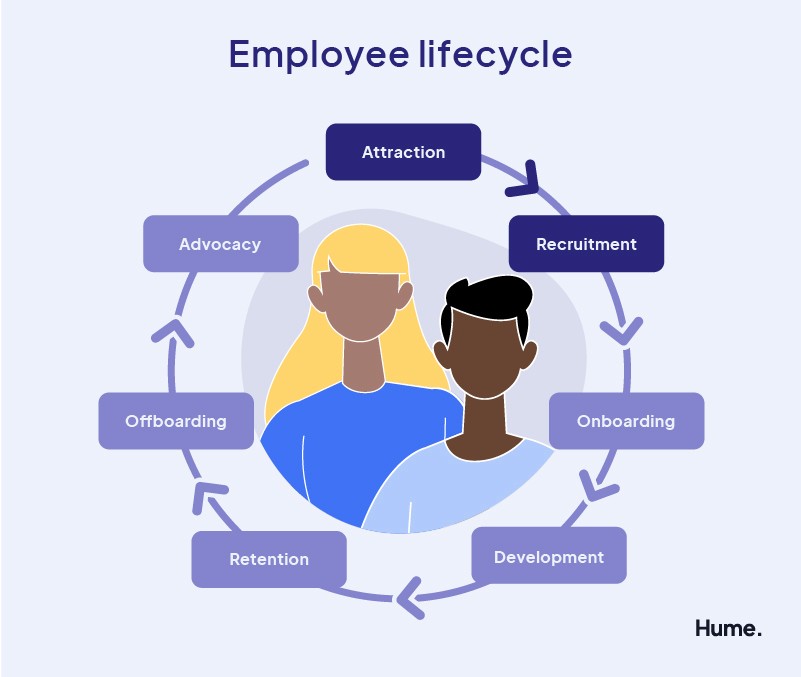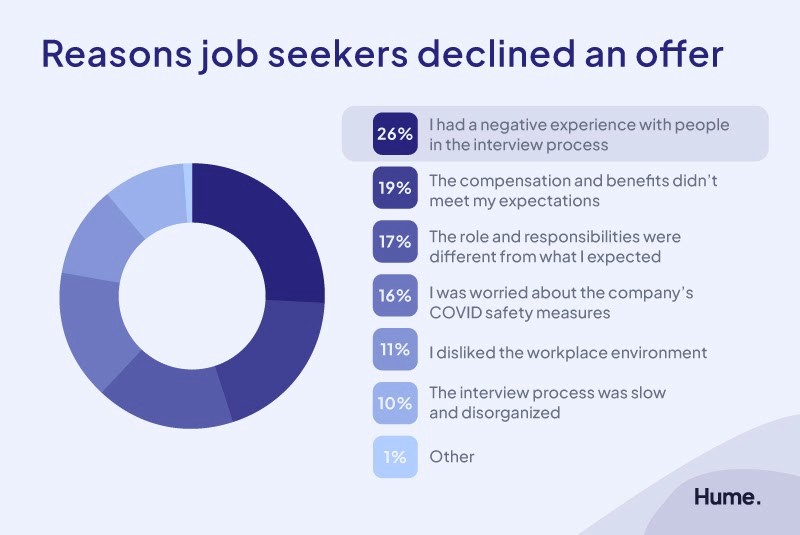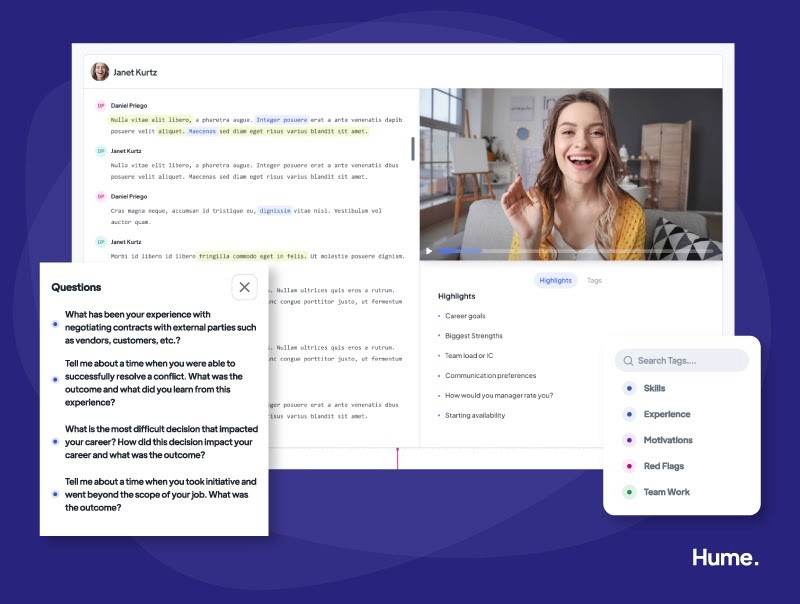Candidate Experience: The Ultimate Guide for Hiring Professionals

2023
In the era of big data, there are all kinds of interesting new points that hiring professionals can measure to improve their own processes as well as the teams they help build. In fact, we talking about an interesting one — quality of hire — in a recent article.
Here’s another modern metric you might not have thought about yet: candidate experience.
Of course you want to create a great experience for every potential hire you come across, but do you know exactly how to, or why it’s actually crucial that you prioritize the candidate journey?
In this ultimate guide, we’ll usher you through all the key points you need to know about candidate experience:
What candidate experience means
All the touchpoints that add up to create this experience
Why it’s so vital to offer thoughtful interactions
Tactics for building an awesome candidate experience
Candidate experience: the key measure of your hiring process
The candidate experience is the sum of all the interactions a job seeker has with a company during the application process.
The candidate experience has a massive impact on how an interviewee feels about an employer. And if an interviewee is hired, this experience also becomes part of the first few stages of their employee lifecycle — so it’s critical that interviewers, HR workers, recruiters, hiring managers, and everyone else in the hiring process knows how to provide a high-quality candidate experience.

6 Recruitment process touchpoints that form the candidate experience
There are a handful of points during the candidate-recruitment interaction that greatly influence the candidate experience:
Job listing
Often, a job listing is the first time a potential candidate will become aware of your business in any meaningful way. That makes this your chance to put your best foot forward and describe the role and the brand in a way that jumps through the screen and really engages the best fits.
However, that doesn’t mean embellishments — the description should still be accurate, clear, and as concise as possible.
Great job listings don’t just happen, they have to be artfully crafted. Hiring teams should work alongside the person who will manage this role, and anyone currently doing the work if possible, to create a job ad that fully encompasses the job and the type of candidate they’re looking for.
To the best of your ability, include things like the job title, responsibilities, required skills, helpful qualifications, location, benefits, and salary. Try to avoid going over the top with requirements and including any negative language that could set the wrong tone from the get-go.
Your business’ digital presence
What’s the first thing pretty much all of us do before applying for a job? Check out the business online!
You should expect that potential hires will be analyzing your digital presence before completing an application. That means your website, your social media profiles, and any information you can control on review sites should all be up to date, on-brand, and as positive as possible.
Your digital presence should showcase your company mission, how you value employees, links to all the roles for which you’re hiring, and any other relevant and helpful information.
Job application
Is there anything more daunting than a long job application that asks for everything short of the location of the Holy Grail? Convoluted applications are a great way to start off the candidate experience on a poor note.
Job applicants can easily spend half a day gathering resources, updating resumes and cover levers, and carefully answering questions for just one job application. Simplify yours as much as you can to inspire them to not just start but to actually finish your application.
Communication from your team
A 2021 report that studied the candidate experience found that more than 80% of job seekers say company responsiveness after their initial application is important in their decision to accept an eventual offer.
Lack of communication is never a good look. And there’s never a worse time to make a bad impression than in the recruitment process.
Respect an applicant’s time and keep your positive employer brand intact by keeping them in the loop about the status of their application. With all the resources out there to automate messages today, there’s no good reason not to send a quick “Your application has been received.” text or a “Sorry, you’re not a good fit at this time.” email.
Interview process
Interviews go both ways. They give businesses the chance to confirm whether or not a candidate is as good a fit in person as they are on paper — and they give candidates a chance to make sure they’re happy with the place they’re going to be spending their days for the foreseeable future.
The interview process should be the positive culmination of what’s been a great experience, and spur interviewees to want to accept an offer quickly if you decide to make one. And for your team, it should efficiently uncover whether the candidate is a good fit who will excel in the role.
Later in this article, we’ll share tips to eliminate biases and create consistency in your interview process so you can build an effective, repeatable workflow.
Post-interview feedback
Again, communication is key when creating a high-quality candidate experience.
After the interview process is over and you haven’t decided to extend an offer, that doesn’t mean the candidate stops existing. Take a moment to quickly provide any feedback that will help them be more successful the next time they go through this process.
Why providing a positive candidate experience really matters
The candidate experience stretches all across the recruitment process. How can you be sure that making a big effort to improve it will be worth the reward? Just consider the following facts.
Job seekers desire positive interview experiences now more than ever
More than half of job seekers care more now about the hiring experience than they did before COVID-19.
And what is it that has the most impact on this hiring experience? The interview process.
The leading reason candidates don’t accept offers is negative interview experiences. Candidates reported feeling that these experiences gave them a bad impression and soured their desire to to work with the company.
Today’s job seekers aren’t just looking for quick employment, they’re prioritizing finding workplaces that align with their wants and needs. The recruitment process you craft will have the largest impact on convincing them that your business can — or can’t — deliver on their goals.

Desirable candidates have the freedom to choose — and they’ll go with the best experience
Top talent typically goes on and off the job market in a matter of 10 days.
Do you think they’re spending that time digging for company information on clunky websites, filling out buggy applications, or waiting days for a hiring manager to confirm their application was received before moving on to the next one?
Of course not.
No matter the state of the market, desirable candidates will have the power to be picky about where they choose to apply, interview, and work.
By delivering a candidate experience that values interviewee time and prioritizes getting them in the door so you can wow them with a well-structured interview, you’ll be ahead of the curve when it comes to competing for top hires.
A poor experience brings down your employer brand
When courting ideal candidates, your brand as an employer is your first impression.
And as we’ve heard time and time again, first impressions are pivotal. This has only become more pertinent in the digital age, when another job listing is just a click away.
A poor experience, especially in the hiring process when candidates are particularly attuned to observing workflows, can lead to negative reviews and bad word-of-mouth “advertising” that impacts your reputation. Considering that over half of job seekers have decided not to apply for a role after reading negative company reviews, a truly bad candidate experience can cost you the talent you’re looking for.
8 achievable tactics to create a great candidate experience
Almost 60% of candidates have declined a job offer based on their experience with the company up to that point.
If you don’t want the money, time, and other resources you spend on hiring to be for naught — here’s how to improve the candidate experience so you always land your top-choice talent.
Reduce friction in applications
It’s not just you who wants to get roles filled fast, quick, and in a hurry. Candidates would love to get hired faster, too!
How can you reduce friction in the application process? First, only ask as many questions and request as many resources as you need to preliminarily confirm they’re a good fit — the rest can be figured out in following steps. Then, make sure the application can be completed on mobile, tablet, and desktop devices. Finally, fill out the job application yourself to make sure it’s as easy and intuitive as you think it is.
If it takes you longer than 10 minutes to complete your own application on your career site, keep reworking until you get your time down.
Create a fair and consistent interview process
A report on CandE winners — high-performers in candidate experience as chosen by Talent Board — found that these companies held structured interviews 40% more often than their low-performing counterparts. Not only does this practice create an impression of fairness among candidates, but it also ensures that hiring pros are making the best selections based on consistent information.
Easier said than done though, right?
We know what it’s like to be pulled in multiple directions every day, hardly feeling like you have time to even prepare for interviews much less make sure you’re asking consistent, bias-free, and effective questions every single time.
So, we set out to create Hume for everyone with the same struggle.
Hume is a talent intelligence platform that accompanies hiring professionals on interviews to record, transcribe, and tag conversations using artificial intelligence. With Hume, you’ll be empowered to create an equitable, consistent interview process that unlocks the insights you need to make smart hires.
Use Hume to chop up any interview and create a highlight reel, which can be easily shared with anyone else on the Hume platform. When everyone in your hiring circle has easy access to key interview moments, your team will have all the information they need to make the quick hiring decision candidates crave — and beat your competition to the punch.
Hume also creates a neutral and accurate record of interviews, so you don’t have to worry that you’re inadvertently making poor hiring decisions or asking ineffective questions based on innate human biases. Interview bias is real — but Hume enables you to go back and review every question to ensure biases are managed and you’re asking consistent questions, comparing candidates across a level playing field, and using an effective strategy to uncover the best fits for every role.
And when you’ve finally found the perfect interview structure, Hume will also help you operationalize that into a company-wide process. Use Hume’s Playlist feature to create a series of coaching videos that guide interviewers through how to sell a role, what questions to ask to uncover cultural fit, how to identify and build on great interviewee answers, and any other best practices that make up your ideal interview process.
With Hume, you don’t have to trade quality for speed. Get on Hume’s waiting list and get ready to host fair, consistent, and effective interviews — the linchpin of pleasing candidate experiences.

Speed up your recruiting processes
Year after year, Talent Board’s study of candidate experience reveals that the recruiting process taking too long is one of the top reasons candidates withdraw themselves from consideration for a role.
And remember, you can’t manage what you can’t measure. Start measuring your hiring efficiency now using time to hire to set a benchmark against which you can measure future recruiting process improvements.
Be transparent on the details – compensation, responsibility, etc.
Ready for another easily-achieved tactic for creating a stellar candidate experience?
Get clear about all the details you already know interviewees want, and do it as early in the process as you can.
Compensation, benefits, job expectations — all of these details can easily be deal breakers if you and the candidate aren’t aligned on them. So why waste everyone’s time by getting to your fifth interview before sharing them? Communicate this information at the first opportunity, whether that’s in the job ad itself, in the application, or at least the first time you talk.
We know that transparency like this still breaks the mold when it comes to hiring. This is your chance to become a trendsetter.
Take the time to communicate
Remember that communication — especially following application completion — is one of the key elements that make up the candidate experience.
Yet, so many companies are still so bad at it.
One young job seeker said that, in a sea of non-communicative companies, a simple text reply was all it took to take them from disinterested in a role to excited for their first phone call.
Here are a few tactics for creating a communication pattern that makes you stand out:
Respond to every applicant as soon as you can after they complete an application. If you aren’t already using a system that can send these kinds of messages automatically, it’s time to start.
Communicate with candidates about their status. Have you already ruled them out? Do you think they’d be a great fit but you’re just working internally to set up an interview time? If they have to reach out and ask you about their status, you’re one step closer to losing them.
Send offers in a week or less
Sending an offer within a week of the final interview increases candidates’ desire to “grow their relationship” with — aka to work with — an employer by 62%.
The data makes it pretty clear that the quicker you extend an offer the more likely you are to win over a candidate you really love.
Engage more during the pre-hire phase
There’s a small window of time between when a candidate accepts an offer and when they start working. This is an especially crucial time to prioritize the candidate experience, as it’s when they’ll make their final decision on whether they’re really ready to join your team — or accept that other offer they received from a competitor.
Employers are starting to understand this delicate situation and invest in pre-hire communication to prevent dropouts. And the more engagement new hires get leading up to their start date, the more likely they are to stay on board.
What does the experience look like in this phase? It looks like providing the chance for new hires to meet their fellow teammates, creating an avenue where candidates can continue to get their questions answered, sending new hire forms digitally, and setting up communications with the hiring manager and/or their future supervisor.
Ask for feedback on the candidate experience you’re building
Earlier we talked about giving candidates feedback. Well, in a healthy system, feedback should go both ways. So our final tip is to ask candidates if they have any feedback for you that you can use to improve your recruiting process and the candidate experience for future applicants.
Formalize this process by creating different surveys that automatically go out to candidates as you accept or reject them within your hiring software.
Keep candidate experience survey questions short and sweet:
What is your satisfaction level with the parts of the hiring process you completed?
Can you describe some of the ups and downs that you experienced?
Did your experience vary across departments? How?
What do you think would have made this experience better for you?
Apply scoring where possible to make the measure of your candidate experience more quantifiable. Then, track these scores and other answers over time to make sure the interactions you’re hosting are only becoming better over time.
Start automating a great candidate experience with Hume
It’s the age of big data and you’ve got more measurements and metrics to keep up with than ever before if you want to close top talent.
Right now, it’s candidate experience — but there are sure to be more and more key elements layered into the hiring process as technology gets smarter, applicants gain digital savvy, and the economy remains uncertain.
Don’t let the overwhelm get to you. There is an achievable first step you can take to apply automation to one of the most important parts of the candidate experience — the interview.
Visit Hume’s homepage to sign up for the waitlist and follow us on LinkedIn to get early access to the interview companion that will upgrade your candidate experience and your talent.



